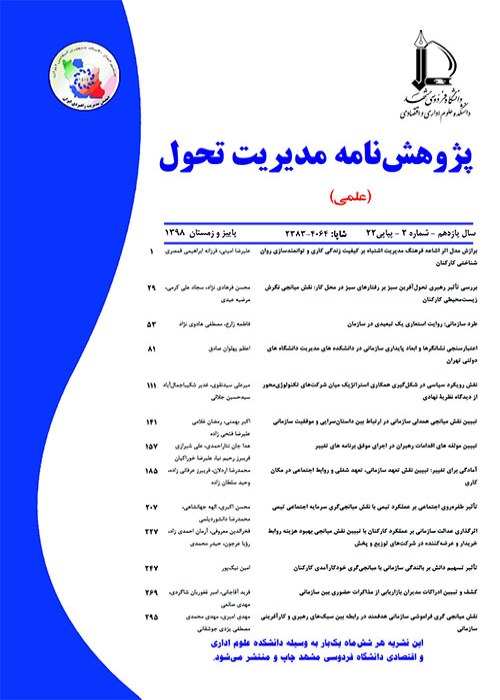Understanding Employee's Strategies for Destructing Managers in Public Organizations
Author(s):
Abstract:
INTRODUCTIONThe concept of deviant workplace behavior has gained attention of organizational scholars because of their destructive effects. These behaviors reduce organizational capacities to realize their planned objectives and consequently decrease organizational productivity and performance. Various types of deviant behavior exist in organization but this research focuses on behaviors done in order to portray public managers in a bad light. Hence, our purpose is identifying employees strategies to discredit their managers and not explaining them. In this way, we could assist managers to diagnose such behaviors, reduce them, and improve well-being of their organizations.
THEORETICAL FRAMEWORKWork place deviant behavior has become an important concern for organizational scholars (Alias & Rasdi, 2015; Kozako, Safin & Rahim 2013). Robinson and Bennett (1995) presented a typology of deviant workplace behavior based on two dimensions (minor-serious, and interpersonal-organizational). Also these behaviors could be positive or negative (Appelbaum, Iaconi & Matousek, 2007). The focus of this research is negative deviant behavior. Actually negative or destructive deviant behaviors violate job description and organizational values (i.e., formal and informal) (Yıldız, 2015).
METHODOLOGYWe conducted a mixed method research to identify destructive strategies. In the first phase (i.e., qualitative phase), an interview had been used, whose objective is to explore strategies, and in the second phase (i.e., quantitative phase), a questionnaire had been used to prioritrize strategies based on rate of use. Statistical population consists of employees and managers of public organizations in Semnan including 45 and 70 participants in quantitative and qualitative phases, respectively. Grounded Theory was employed to analyze interviews and Friedman tests were used to accept and prioritize strategies.
RESULTS & DISCUSSIONIdentified strategies in order of importance are managerial, verbal- communicative, political, and religious, personality, work, performance, and emotional- psychological mechanisms.
CONCLUSION & SUGGESTIONSFuture researchers could examine each strategy as a variable and identify antecedents and consequences of it in organizations. Most of these behaviors have phsycological reasons; hence, cooperation of psychologists and organizational scholars is essential for reducing them.
THEORETICAL FRAMEWORKWork place deviant behavior has become an important concern for organizational scholars (Alias & Rasdi, 2015; Kozako, Safin & Rahim 2013). Robinson and Bennett (1995) presented a typology of deviant workplace behavior based on two dimensions (minor-serious, and interpersonal-organizational). Also these behaviors could be positive or negative (Appelbaum, Iaconi & Matousek, 2007). The focus of this research is negative deviant behavior. Actually negative or destructive deviant behaviors violate job description and organizational values (i.e., formal and informal) (Yıldız, 2015).
METHODOLOGYWe conducted a mixed method research to identify destructive strategies. In the first phase (i.e., qualitative phase), an interview had been used, whose objective is to explore strategies, and in the second phase (i.e., quantitative phase), a questionnaire had been used to prioritrize strategies based on rate of use. Statistical population consists of employees and managers of public organizations in Semnan including 45 and 70 participants in quantitative and qualitative phases, respectively. Grounded Theory was employed to analyze interviews and Friedman tests were used to accept and prioritize strategies.
RESULTS & DISCUSSIONIdentified strategies in order of importance are managerial, verbal- communicative, political, and religious, personality, work, performance, and emotional- psychological mechanisms.
CONCLUSION & SUGGESTIONSFuture researchers could examine each strategy as a variable and identify antecedents and consequences of it in organizations. Most of these behaviors have phsycological reasons; hence, cooperation of psychologists and organizational scholars is essential for reducing them.
Keywords:
Language:
Persian
Published:
Transformation Managemet Journal, Volume:8 Issue: 1, 2016
Pages:
1 to 15
magiran.com/p1757656
دانلود و مطالعه متن این مقاله با یکی از روشهای زیر امکان پذیر است:
اشتراک شخصی
با عضویت و پرداخت آنلاین حق اشتراک یکساله به مبلغ 1,390,000ريال میتوانید 70 عنوان مطلب دانلود کنید!
اشتراک سازمانی
به کتابخانه دانشگاه یا محل کار خود پیشنهاد کنید تا اشتراک سازمانی این پایگاه را برای دسترسی نامحدود همه کاربران به متن مطالب تهیه نمایند!
توجه!
- حق عضویت دریافتی صرف حمایت از نشریات عضو و نگهداری، تکمیل و توسعه مگیران میشود.
- پرداخت حق اشتراک و دانلود مقالات اجازه بازنشر آن در سایر رسانههای چاپی و دیجیتال را به کاربر نمیدهد.
In order to view content subscription is required
Personal subscription
Subscribe magiran.com for 70 € euros via PayPal and download 70 articles during a year.
Organization subscription
Please contact us to subscribe your university or library for unlimited access!


